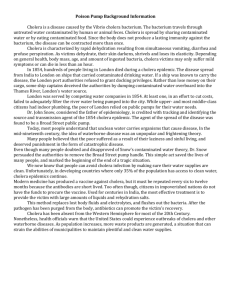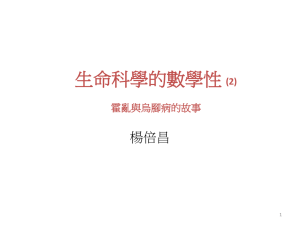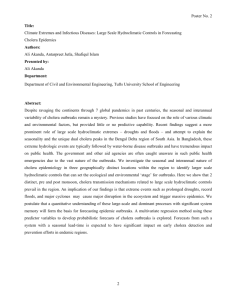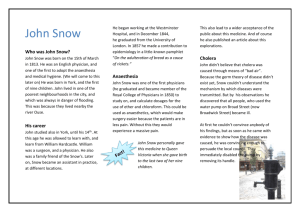Zimbabwe Mainstreaming protection into the cholera response ENG
advertisement
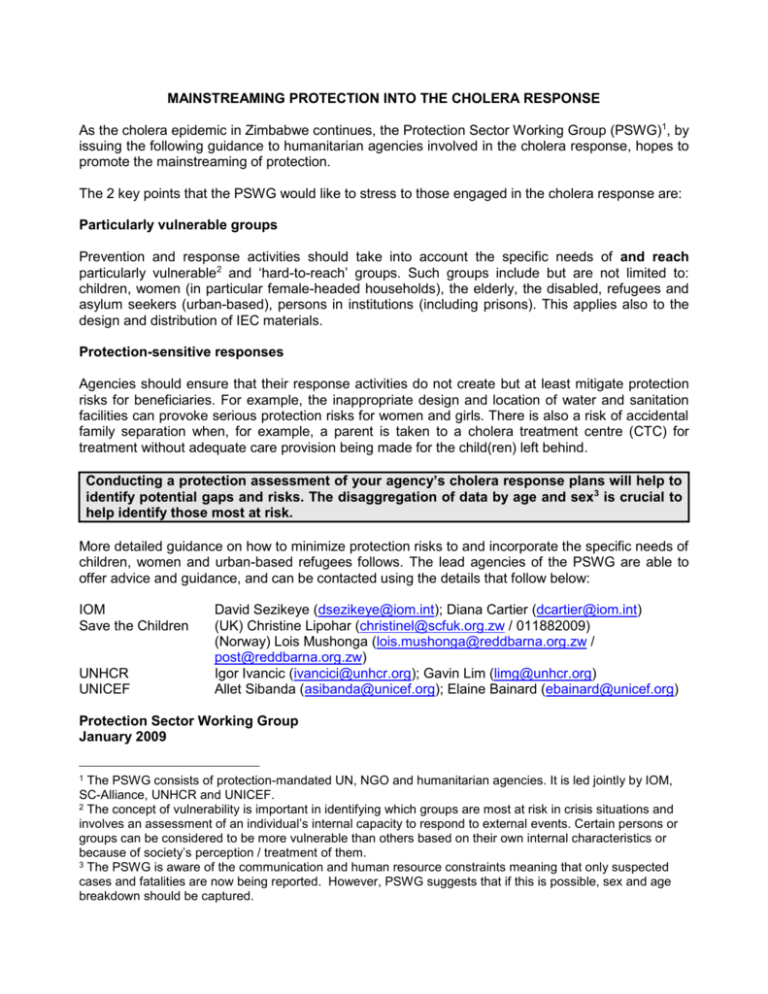
MAINSTREAMING PROTECTION INTO THE CHOLERA RESPONSE As the cholera epidemic in Zimbabwe continues, the Protection Sector Working Group (PSWG)1, by issuing the following guidance to humanitarian agencies involved in the cholera response, hopes to promote the mainstreaming of protection. The 2 key points that the PSWG would like to stress to those engaged in the cholera response are: Particularly vulnerable groups Prevention and response activities should take into account the specific needs of and reach particularly vulnerable2 and ‘hard-to-reach’ groups. Such groups include but are not limited to: children, women (in particular female-headed households), the elderly, the disabled, refugees and asylum seekers (urban-based), persons in institutions (including prisons). This applies also to the design and distribution of IEC materials. Protection-sensitive responses Agencies should ensure that their response activities do not create but at least mitigate protection risks for beneficiaries. For example, the inappropriate design and location of water and sanitation facilities can provoke serious protection risks for women and girls. There is also a risk of accidental family separation when, for example, a parent is taken to a cholera treatment centre (CTC) for treatment without adequate care provision being made for the child(ren) left behind. Conducting a protection assessment of your agency’s cholera response plans will help to identify potential gaps and risks. The disaggregation of data by age and sex3 is crucial to help identify those most at risk. More detailed guidance on how to minimize protection risks to and incorporate the specific needs of children, women and urban-based refugees follows. The lead agencies of the PSWG are able to offer advice and guidance, and can be contacted using the details that follow below: IOM Save the Children UNHCR UNICEF David Sezikeye (dsezikeye@iom.int); Diana Cartier (dcartier@iom.int) (UK) Christine Lipohar (christinel@scfuk.org.zw / 011882009) (Norway) Lois Mushonga (lois.mushonga@reddbarna.org.zw / post@reddbarna.org.zw) Igor Ivancic (ivancici@unhcr.org); Gavin Lim (limg@unhcr.org) Allet Sibanda (asibanda@unicef.org); Elaine Bainard (ebainard@unicef.org) Protection Sector Working Group January 2009 1 The PSWG consists of protection-mandated UN, NGO and humanitarian agencies. It is led jointly by IOM, SC-Alliance, UNHCR and UNICEF. 2 The concept of vulnerability is important in identifying which groups are most at risk in crisis situations and involves an assessment of an individual’s internal capacity to respond to external events. Certain persons or groups can be considered to be more vulnerable than others based on their own internal characteristics or because of society’s perception / treatment of them. 3 The PSWG is aware of the communication and human resource constraints meaning that only suspected cases and fatalities are now being reported. However, PSWG suggests that if this is possible, sex and age breakdown should be captured. Annex 1: Children and the cholera response Children’s special developmental needs should not be overlooked in the design and implementation of interventions. Age and Sex Disaggregation of cholera patients Age and sex disaggregated data of children is needed so we better understand who are affected and can better protect them. Currently there are NO such statistics. Ideally, disaggregate by (05), (6-12), (13-17) years, but at a minimum (0-5) and (6-17). Awareness and Prevention of Accidental Family Separation In a medical emergency, children can become separated from their parents depending on how the response is being carried out [or implemented]. This is devastating to children and can lead to permanent family separation, especially if the child is young. To prevent such occurrences: If a sick mother is admitted to the clinic accompanied by a young child/baby, obtain identity and next-of-kin information, so that if she dies, the baby’s family can be traced; Never remove a sick child from a community / family without documenting next-of-kin information and keeping it with the child, so that the child can be traced back to his/her family when he/she is discharged; Do not remove a sick mother from her young children without ensuring that the children are left under the care of adult relatives / neighbours. Make sure the temporary caregiver knows where you are taking the mother; When an adult is admitted, check to see whether she/he has left children behind without having been able to make adequate care-giving arrangements. If yes, contact a child-focused NGO or Ministry of Social Welfare to provide follow up with the children; If you become aware of any child who has become separated from his /her parent or caregiver, urgently notify an agency that can provide immediate assistance (Ministry of Social Welfare, child protection NGO, UNICEF). Babies and very young children in this situation should be given the highest priority. Health and hygiene education around cholera (signs, symptoms, prevention) Children need to get information first hand – this means providing information in places where children congregate: schools, churches, play areas, crèches, children’s clubs, children’s institutions (places of safety, remand homes, orphanages), as well as during house-to-house visits; Raise awareness of children under the age of 5 at Early Childhood Development (ECD) centres and crèches, through play, demonstration, role playing. These children will automatically take the learning home to their mothers or other caregivers; Train / involve adolescents in peer-to-peer education and information dissemination – they are much more successful at reaching other children, than adults; Don’t forget about hard-to-reach children such as child caregivers, child headed households, children living in households with disabled household heads, adolescent wives, out-of-school children including street and working children; IEC materials need to be child friendly (appealing, attractive, easy for children to read and understand, developed in all languages). Children at Cholera Treatment Centres / Hospitals/Clinics Hospitalised children need psycho-social support to help their recovery. Exposure to sick and dying people, or the absence of their usual caregiver will provoke fear and anxiety that could have lasting effects; To help support children’s emotional recovery, identify personnel (consider calling on volunteers from child-focused NGOs) who can spend time reassuring them, and helping them understand what is going on. Providing children with play items such as crayons, paper, washable toys will also help them to cope with their negative experience; Ideally, place children in a ward separate from adults, with separate nursing care. Distribution of Water Purification Tablets Distribute tablets to institutions housing children (schools, orphanages, etc); Ensure child caregivers understand how to use the tablets. Access to treated and reticulated water Ensure children who are fetching water have age appropriate buckets and jerry cans; Women and children can be sexually abused or exploited in the process of collecting water or firewood. This needs to be factored into your programming response. Assessment Questions to Identify Child Protection / Family Separation Issues When carrying out cholera response assessments, remember to explore child-related issues: Who is caring for children left behind when the caregiver is hospitalized? The survival of these children may be at stake and they may be at risk of abuse or other harm. How are child-headed households coping when the head of their household is admitted e.g. who is caring for the siblings, especially younger children? Are there any children being admitted who don’t know where their parents are? Or who don’t have parents? What happens to these children when discharged? Do sick parents ever arrive at the CTC accompanied by babies or young children? If yes, what happens to these children? While on one hand, admitting them with their mothers can put them at risk of cholera exposure, they also cannot be left without care. Is anything in place at the community level to provide care for such children? Or at clinic level to prevent the baby’s exposure to cholera? What are the concerns for hospitalized children – in terms of their medical/physical care (food, etc) and emotional support? What needs to be done? Is anything putting children at risk of harm or exclusion in the way that the cholera prevention and response is being undertaken? What ideas do children have for improved cholera response to address their particular needs? Consider calling on child-focused NGO staff/volunteers to support health clinics in carrying out tasks such as child protection screening providing support to children who are hospitalized or otherwise seriously affected by the cholera epidemic (family death, separation, etc). Annex 2: Women and the cholera response Women are more vulnerable to cholera due to the gender roles ascribed to them Women have less access to resources: Social networks and influence; transportation; economic resources; personal mobility; control over decision-making or resources that are extremely critical to be able to save oneself from the morbidity and mortality of cholera; Women are victims of the gendered division of labour: Women are primarily responsible for domestic duties such as fetching water, preparing food, coming into contact with raw food stuff, cleaning toilets and care for sick, disabled and elderly in the family. All of their daily chores expose them to the risk of acquiring cholera; Women-headed households with a double burden: As widowhood due to HIV and migration among men is a common phenomenon in the country, there are many women- headed households in the country. Women are hence forced to play the dual role of being economically productive as well as performing domestic duties. The added responsibilities diminish women’s willingness and ability to access health care. Due to the lack of male members in the family, women are often forced to attend to funeral practices exposing themselves to the risk of cholera; Women as caregivers: Moreover, gender roles dictate that women become the primary caretakers for those affected by cholera in the family substantially increasing their emotional stress and material work load and increasing their susceptibility; Pregnant women and girls: Due to their physical and emotional condition, pregnant women and girls have limited mobility and are dependent on the support of husbands and other family members. During a crisis, family disruption occurs and support mechanisms may disappear. Pregnant women and girls face greater marginalization when their dietary intake is deficient and when both ante- and post-natal clinics and supplementary feeding programmes are not in place. The likelihood of physically and mentally underdeveloped infants increases. Cholera also has a direct impact on the pregnant women predisposing to fetal deaths and complications arising out of retained placenta. Incorporating gender issues in Cholera response Ensure gender sensitive preventive messages are provided to the community which would help women to take adequate measures to prevent themselves from acquiring cholera; Engaging women as full and equal partners in community-based social mobilization campaigns and integrating women at the highest levels of planning and decision making in community (particularly with respect to the health needs of women, including reproductive health services) and employing women as primary distributors of emergency rations and medical supplies. Women should also be actively consulted in location of boreholes, water distribution points and distribution of hygiene supplies; Special attention to be provided to pregnant women and girls in CTCs and health workers trained to handle obstetric emergencies; Take cognizance of the health sector collapse and the sexual and reproductive health concerns of women and girls and support sexual and reproductive health programmes for vulnerable women and girls. Annex 3: Urban-based refugees and the cholera response The Government of Zimbabwe in co-operation with UNHCR caters for needs of refugees and asylum-seekers. While the majority reside at Tongogara refugee camp, Chipinge District, Manicaland Province, some 1200 refugees and asylum-seekers are urban based, in particular in Harare. Refugees at Tongogara benefit from the camp based clinic in addressing their medical needs. In case of a cholera outbreak, the clinic is likely to be a centre for the coordination of the wider response in the area, including catering for needs of the local population estimated at some 2.000 residents. Refugees in an urban context need to rely on the safety net provided by the ongoing response mechanisms and facilities. In that respect the following basic points should be borne in mind: Refugees in urban settings are mostly found in Harare (such as in Waterfalls neighbourhood and in the Avenues). Smaller numbers also reside in Mutare and Bulawayo; Refugees and asylum-seekers may not be in possession of identity documentation like that of Zimbabwean nationals. However, they are documented with ID Cards issued jointly by UNHCR and the Government confirming their identity, legal status and ID number. This should not hamper their access to medical assistance as their condition may require. The validity of identity documentation issued to refugees and asylum-seekers is recognised by the authorities; While refugees and asylum-seekers are expected to reside at Tongogara camp – where their medical needs are addressed through the onsite clinic – they should not be denied emergency medical treatment, in accordance with international human rights standards, when they find themselves in other parts of the country. Refugees and asylum seekers should be rendered services and assistance on the same basis as Zimbabwean nationals as they are legal residents of Zimbabwe. Rendering protection and assistance to refugees and asylum-seekers is the responsibility of the Government of Zimbabwe, in accordance with the 1983 Refugees Act. Should any cases of identified cholera involve refugees, the Department of Social Welfare, the Office of the Commissioner for Refugees and UNHCR may be notified for information sharing and any special assistance related purposes (such as addressing family reunion needs, assistance to unaccompanied and separated children, women headed households, and other vulnerable cases).


